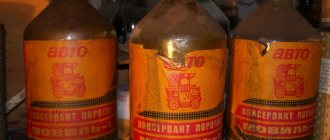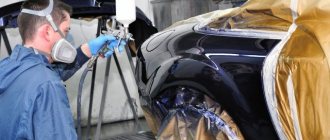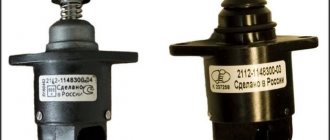Hello dear readers of the kuzov.info blog!
This review article will tell you about the types of car waxes, their application, advantages and disadvantages.
There are hundreds of wax-based products available today. They can be divided into the following categories:
- Liquid waxes
- Waxes in paste form
- Wax sprays
- Sealants for body protection (sealants)
For some car enthusiasts, waxing a car is a huge pleasure. Thus, they seem to achieve perfection in the appearance of the car. They are ready to polish the body every day. Such people are willing to spend a lot of time waxing, using products that are applied in several stages.
For other people who value their time very much, but at the same time want their car to be well-maintained, they need a simple and quick solution to restore the shine and protect the body. For both categories of people, there are products that can give excellent results. Let's look at the preparation and waxing process.
You need to start by cleaning the surface
Before applying any protective waxes, the car body must be washed. Simply washing the body will not be enough; ingrained dirt and stuck solid particles remain on the surface. For more thorough cleaning after washing, universal cleaning waxes, cleaning clays and other compounds are used. Let's take a closer look at the advantages and disadvantages of these cleaning methods.
The reason Turtle Wax 2in1 waxes have been so popular is because they are both a cleaner and a waxing product. Many people now use a synthetic cleaning clay first and then apply wax to the clean paint.
Wax composition 2in1 (cleaner and protection wax) vs cleaning clay + wax
Most modern cars have a clear coat, even if the paint is not metallic. This coating differs from coatings without varnish. Modern varnish coatings are applied in a thin layer. This is done in order to save money and reduce the final cost of the car. Thus, it is not correct to regularly use abrasive products to clean and polish the body. 2in1 wax compounds are both wax-based cleaners and polishing compounds. As cleaners they contain abrasive particles. The reserve thickness of the varnish will not allow you to do a lot of abrasive polishing. It is advisable to use cleansing clay and then use wax that does not contain cleaners. You can read more about using cleansing clay here.
Polish to remove imperfections...before waxing
If the car you are going to wax has minor scratches and abrasions, then you first need to apply abrasive polishing. Some people mistakenly believe that applying wax will remove minor defects. Before applying wax, you need to remove small scratches, traces of dried water, and abrasions. All this can be eliminated or smoothed with abrasive polishing. Wax will simply preserve the cleaned and restored surface.
Expected effect
Not everyone fully understands why waxing cars and what effect can be obtained from such a procedure.
In fact, such processing is not considered mandatory, and it is performed purely at the request and personal initiative of the motorist. But if you understand what this wax is for and what it does to the car body, many will change their attitude towards the product and want to use it themselves.
Like all elements, paintwork has a limited service life. Gradually, the paint becomes duller, and damage and cracks form on the surface of the paintwork. In many ways, this can already give many an answer to the question of why to cover your car with special wax.
Such auto chemical products help eliminate:
- scratches;
- chips;
- microcracks.
Let's take a closer look at what wax does when washing a car. The substance, distributed over the surface of the body, fills all defects and microcracks. This allows you to create a flat and smooth surface.
Wax has hydrophobic properties, forming a kind of film when the substance hardens. Additionally, the paintwork becomes brighter and more shiny.
The created coating has decent protective characteristics. It helps to minimize the negative impact from:
- ultraviolet radiation;
- car detergents;
- mud;
- dust;
- chemical reagents, etc.
To ensure maximum effect, it is recommended to apply the product in at least 2 layers.
As for whether it is necessary to wipe your car immediately after applying a layer of wax, it depends on the specific product chosen and the instructions for use provided for it.
Applying car wax using a spray
Spray wax can be considered the easiest way to apply wax protection. Spray wax now rivals the best liquid and paste waxes. Wax sprays use polymers that provide good protection.
Many polymer spray-on protective coatings can be applied even in open sun. Of course, for best results it is better to use them in the shade. For example, Meguiar's Ultimate Quik Wax (spray wax) can provide the same level of protection as Meguiar's NXT Generation Tech Wax.
To apply spray wax, you must first thoroughly wash your car. Next, you need to prepare a special microfiber towel for polishing. You need to apply the wax and immediately rub it with this towel. Thus, it is better to treat the surface in small segments. After treating the entire panel, you need to turn the towel over and, using the clean side, you need to finally polish the entire surface again. This way you will evenly distribute the applied protective composition.
How to remove wax from a car
Old car wax is removed if, after the expiration of the operational period, it remains on the surface of the car. It is impossible to carry out treatment with a new substance if the old protective coating remains.
To remove it use:
- special spray cleaner;
- clay.
In both cases, the substance is applied to the surface of the car and left there for a while, after which it is washed off with a rag or towel with microfibers.
Do not use standard detergents to remove old coating.
Application of liquid wax and paste wax
In the past, paste waxes were the most preferred as they gave good results. Nowadays, many manufacturers offer liquid and paste versions of wax, which have the same composition. What is their difference? It all depends on preference and application method. Many people find that paste waxes are more suitable for hand-polishing, while liquid waxes are more suitable for use with a polisher.
There is no need to overdo it with the amount of wax applied. This applies to both paste and liquid wax. Less is better. You should get a uniform thin wax layer. For modern polymer waxes, a thick layer is not necessary. A thin layer dries faster and is easier to rub.
When applying liquid and paste waxes, follow these instructions::
- Treat the surface in the shade, where there is no direct sunlight.
- Use a special applicator recommended by the manufacturer or available with wax. A foam sponge is usually suitable.
- Treat body panels in segments of 20 - 40 square centimeters. Some products can be applied to the entire car before rubbing.
- You need to check in the instructions for the product you are using whether you need to wait for the wax to dry before rubbing it. Some products require drying before rubbing, and some need to be rubbed in immediately after application.
- Always use a small amount of rubbing wax. Using too much wax will only waste it. If you apply a lot of wax and it doesn't rub well, try switching sides of the microfiber towel and repeat rubbing with the clean side.
After waxing, the surface should be smooth and shiny, without streaks or smudges of wax.
What to do if, after all the work done, you still have streaks and areas where the wax is difficult to rub. There are several techniques for this. The simplest one is to park the car under the sun for 10–15 minutes. The wax will heat up, but you can’t let it get hot, then again you need to go into the shade or garage. Next, using a clean microfiber polishing towel, you can easily buff the wax to a shine.
When and how to apply wax?
Wax is applied after washing the car. It is necessary not only to clean the car of dirt, but also to remove the polish remaining from the previous treatment.
Each type of product has its own application technology, which involves manual work or the use of special devices.
It is not recommended to use the polish in hot weather under the sun's rays, so that the wax does not dry out before the required time and does not turn into a matte lump instead of a glossy film.
Before processing, you need to dry the body. Then apply the substance evenly and rub it with a napkin. It is recommended to treat the surface in small areas. After drying, wipe the entire area with a woolen rag.
It is not advisable to use a polishing machine for processing, because... the film will be thin, which will affect its functionality.
Hand movements should be directed from top to bottom to avoid grains of sand that could scratch the paint.
Transparent sealants (sealants) to protect paint surfaces
In addition to classic waxes, there are transparent sealants (sealants) to protect the painted surface. They consist entirely of synthetic ingredients. Paint sealants provide longer lasting protection than waxes. They are very easy to apply. The disadvantage is the shallow, superficial shine they give. Some waxes with natural ingredients or a combination of natural and synthetic ingredients provide a deeper shine.
Before applying the sealant, you need to wash and dry the car body. Paint protection sealants are hydrophobic, so no water should come into contact with the surface during application.
The main principle of applying such sealants is that you need to apply a thin layer of the composition and leave for 20-30 minutes. Such synthetic sealants are applied immediately to the entire surface. Can be applied in a circular motion, distributing the composition evenly. There is no need to grind the composition, as is done with classic waxes.
Sealants can also be applied to glass, chrome parts and plastic.
Peculiarities
You should choose wax taking into account the cost, since inexpensive options quickly lose their original properties.
New cars under 5 years of age are usually treated with solid and liquid materials. For older cars, abrasive waxes and polishes are used. The difference between wax and polish is that the first material creates an additional protective layer on the surface of the body, while polish improves the external properties by removing the top layer of paintwork. Wax containing abrasives has the same principle of action as polish. Therefore, when choosing wax for your car, you need to take this parameter into account. Abrasive options should be used for cars that have any paint defects, for example, in the form of scratches or faded paint. It must be taken into account that abrasive components vary in degree of hardness. The hardest options resemble grains of sand in appearance and feel.
For new cars that do not have paint defects, wax options that do not contain any abrasive components should be used.
Applying hard wax to a car
Small scratches spoil the appearance of the car. Hard car wax will help eliminate minor defects and protect the paintwork from new damage. This product will add shine to the surface, making the color deeper and more noble. We offer the application of hard wax to cars at the Dram Auto detailing center. We use formulations from the world's best brands in the field of professional auto chemicals. We carry out thorough surface preparation and guarantee high quality of services provided.
Proper preparation and application will help ensure high quality results. The work is performed in the following order:
- body wash;
- removal of greasy stains and stubborn dirt;
- treatment of paintwork with cleaning clay;
- hard wax treatment using a clean applicator;
- polishing after the composition has dried.
It is not recommended to apply the product in a thick layer. A soft polishing towel is used for polishing.
Types of liquid wax
Which car wax is best?
In order to answer this question, you need to know what modern wax coatings are? The question is quite ambiguous for the reason that there are three types of waxes: Cold car wax , as a rule, is a liquid containing a large amount of cationic surfactants (surfactants) and emulsion wax. When applied, it fills microcracks, irregularities, scratches, creating a protective layer and adding shine to the coating. This coating makes car washing easier and speeds up drying. This wax is applied and polished by hand. The disadvantage of these types of waxes is their relative fragility. For the best effect, it is advisable to use them after every one or two washes.
Hot car wax is a fat-like substance that can be either artificial or natural. Its melting point ranges from forty to ninety degrees. Waxes from renowned manufacturers most often use carnauba wax, which has complete transparency, a high melting point and is highly resistant to wear. It is believed that this type of wax retains its protective properties for six to twelve months. When applied, it is diluted with hot water in appropriate proportions and applied with a sponge or cloth and polished. Corrosion inhibitors are often added to hot waxes, stopping the corresponding processes in the metal of the car body. Due to the use of rather expensive raw materials in hot waxes, their cost is also quite high.
Foam waxes have properties similar to hot waxes. To apply this type of wax, special equipment is required due to the fact that air is supplied to the mixture of water and wax composition, thus creating a foam emulsion, which, when applied to the surface of the car, is better retained on it and polishes more evenly.
Regular car waxing will keep your car in good condition for a long time.
Application
As mentioned, it is possible to apply all types of wax by hand, with the exception of foam. In any case, before creating the coating, it is necessary to clean the body of dirt by washing. Washing should be done using a non-contact method.
Waxing should not be done in the sun. You must first shake the composition thoroughly. Self-treatment of a car with liquid wax consists of applying it to a body surface that has not dried after washing and rubbing it with a napkin or rag.
It should be noted that liquid wax is often included in the cost of washing or is offered as an additional service at a low cost. However, the feasibility of using this material is questionable, since this service increases the cost of washing, and in order to maintain the effect it is necessary to repeat this operation every time. This explains the low cost of washing a car with this wax, which is 1-2 dollars.
Hard wax car body treatments at car washes range from $12 to $250. This difference in cost compared to liquid wax is explained by more complex application technology. In addition, the materials have a high cost, which can reach $500 per jar of hard wax.
It should be noted that liquid wax and spray versions are much more widespread compared to hard and synthetic wax. This is explained, first of all, by the high cost of applying the latter to the car body. Naturally, such wax is not intended for general use. It is usually used for expensive cars to protect them from damage to the paintwork. Treating cars with such wax on your own is also rarely used, due to the complexity of this process. Washing your car with car shampoo containing wax or applying liquid material is naturally much easier.











